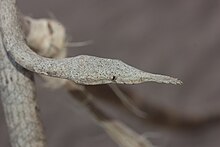To establish botany via the Ivy tree is to understand that "Ivy" is "Hedera, commonly called ivy (plural ivies), is a genus of 12–15 species of evergreen climbing or ground-creeping woody plants in the family Araliaceae, native to western, central and southern Europe, Macaronesia, northwestern Africa and across central-southern Asia east to Japan and Taiwan." as per Wikipedia at https://en.wikipedia.org/wiki/Hedera. The Banyan Tree will be applicable to this piece of evolution and to announce the possible ninth yard of the animal species and it's continued discovery of such powerful methods to display:
This write concludes idea: Evolved from the snake to a giraffe.
Spotted Leaf-nosed snake:
To the giraffe, question the komodo dragon!
Langaha madagascariensis
| Langaha madagascariensis | |
|---|---|

| |
| Female L. madagascariensis | |
| Scientific classification | |
| Kingdom: | Animalia |
| Phylum: | Chordata |
| Class: | Reptilia |
| Order: | Squamata |
| Suborder: | Serpentes |
| Family: | Lamprophiidae |
| Genus: | Langaha |
| Species: | L. madagascariensis
|
| Binomial name | |
| Langaha madagascariensis Bonnaterre, 1790
| |
| Synonyms | |
| |
Langaha madagascariensis (formerly Langaha nasuta, commonly known as the Madagascar or Malagasy leaf-nosed snake) is a medium-sized highly cryptic arboreal species. It is endemic to Madagascar and found in deciduous dry forests and rain forests, often in vegetation 1.5 to 2 meters above the ground.[1][3]
Description
Malagasy leaf-nosed snakes can grow up to 1 meter in length.[3] There is considerable sexual dimorphism within the species; the males are dorsally brown and ventrally yellow with a long tapering snout, while the females are mottled grey with a flattened, leaf shaped snout.[4] The function of their appendage is unknown, but obviously also serves as camouflage.[3]
It is largely a sit-and-wait predator. It may show curious resting behaviour, hanging straight down from a branch. Prey items include arboreal and terrestrial lizards.[5] It also exhibits hooding while stalking prey. These hooding and swaying behaviours along with its cryptic colour patterns, might allow L. madagascariensis to mimic a vine swaying in the wind.[6]
Leaf-nosed snakes are oviparous with clutch sizes ranging from 5 to 11 eggs.[3] Malagasy leaf-nosed snakes are generally calm and reluctant to bite unless provoked. Envenomation by the snake causes severe pain in humans, but is not deadly.[7]
References
- D'Cruze, Neil C. (2008). "Envenomation by the Malagasy colubrid snake Langaha madagascariensis". Journal of Venomous Animals and Toxins Including Tropical Diseases. 14 (3): 546–551. doi:10.1590/S1678-91992008000300014.
| Wikimedia Commons has media related to Langaha madagascariensis. |
















No comments:
Post a Comment